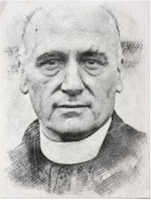As we saw in the previous posting on this subject, the dominance of Msgr. John A. Ryan over the interpretation of social teaching — achieved by shifting from reason to faith (meaning personal opinion heavily influenced by socialism) — meant that any who opposed socialism were ipso facto heretics instead of simply mistaken or even right when Ryan was wrong. Ryan’s influence even extended to having his students hint that Fulton Sheen was a “traitor to Christ” for saying things that Ryan didn’t want to hear.
Ryan’s whole idea was that the government should run everyone’s life. He paid lip service to the natural and inalienable rights to life and liberty, but fudged on private property, which he characterized as a natural right, but not like other natural rights in being alienable! Given that natural rights are by definition inalienable, one wonders why no one seemed to catch on to what Ryan was doing . . . which was to give the State total charge of everything.
Ryan’s ad hominem attacks on virtually everyone who disagreed with him may have been the reason Dorothy Day and the Catholic Worker movement broke with the Catholic Radical Alliance of Pittsburgh, organized by students of Ryan. That was contrary to Day’s philosophy and orientation on love fulfilling justice, as well as her pacifism — words can cause even more harm than a physical blow in some cases and do far more damage to the social order as well.
 |
| Msgr. J.A. Ryan |
The social order, however, was not something that Ryan, a quintessential collectivist (as long as he could retain his individuality, a common phenomenon among socialist thinkers — collectivism is for others, not them) appears to have understood. The social order was to be reformed by the government giving orders, and people obeying them.
Obviously, Ryan failed to grasp the essence of the act of social justice as the way to restructure the social order and bring people together, which is the whole point of the Quadragesimo Anno, the encyclical Ryan claimed “vindicated” him. As Ferree commented on the analysis of the encyclical by Ryan and others,
The term “Social Justice” is used ten times in this encyclical, and there are many other passages where the same idea occurs but without the technical name. Yet very few commentators over the years seem to have realized that this is the subject, and the most important point, of the papal teaching. These commentators discuss the living wage, the family wage, property, labor, capitalism, competition, monopoly, class war, Communism, subsidiarity, corporations, etc. — all the details that are used for explanation and illustration — but they miss the great subject of the whole encyclical! (Ibid.)
 |
| Hilaire Belloc |
More immediately, Ryan downplayed and marginalized the primary tool by means of which the restructuring of the social order is to be established and maintained: widespread private property in capital, through what Belloc a few years later would term “the restoration of property.” (Belloc, An Essay on the Restoration of Property, op. cit.) The act of social justice is impossible unless people are free to organize and act to reform their institutions (Quadragesimo Anno, § 87), and that requires the power that ordinarily comes from widespread private ownership of capital.
Private property and capital ownership are specifically mentioned fifty-two times in Quadragesimo Anno — so often that Pius XI felt compelled to remind readers that neither private property nor wages are the point of social justice. (Ibid., 76.) Nevertheless, private property is identified as the primary means of vesting people with the power both to lead virtuous lives, and to organize and restructure the social order to enable them to lead virtuous lives. Wages and pay are mentioned twenty-nine times, always either as subordinate to, or as an expedient in lieu of widespread capital ownership.
 |
| Fr. William J. Ferree, S.M., Ph.D. |
Ryan’s particular focus, however, caused him to reverse this emphasis. He ignored Pius XI’s reason-based conception of social justice in favor of his own faith-based understanding that merged distributive and legal justice, and omitted commutative justice entirely. As Ferree commented on Ryan’s accomplishment,
It may seem incredible that so clear and scientifically exact a statement should be interpreted that social justice must somehow straddle the traditional fields of both legal and distributive justice, dipping now into one and now into the other, but it has been so understood. (Ferree, The Act of Social Justice, op. cit., 104, 139n.)
Nor, as we will see in the next posting on this subject, was that the most egregious misinterpretation Ryan inflicted on social teaching to turn it into socialism.
#30#

